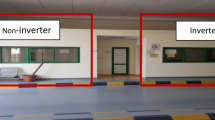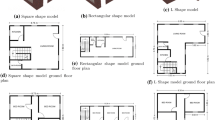Abstract
The location of exhaust air vents of an evaporative cooling system can have significant effects on providing thermal comfort and controlling humidity, temperature and air distribution in buildings. In the current study, four different strategies have been evaluated for exhaust air vent locations to provide the optimum thermal comfort inside a typical residential house. This study provides a numerical solution for temperature and relative humidity profiles in the residential house and within the living space in each room typically at a height of 1.8 m or less. By evaluating different exhaust air vent locations in a room, the best strategy(ies) to provide more appropriate thermal comfort condition and obtained and as a conclusion, the exhaust vents should be located on furthest wall away from the entrance of the room and in the middle. The results provided in the current study can eventually be applied in the design of evaporative cooler exhaust vent systems in residential buildings and lead to improve the performance of these systems.
Similar content being viewed by others
Abbreviations
- A 1 :
-
ceiling area (m2)
- A 2 :
-
roof area: 1.6 times of the ceiling area (m2)
- C p :
-
specific heat capacity (J/(kg·K))
- DR:
-
draft rate
- g :
-
acceleration of gravity (m/s2)
- k :
-
kinetic energy (J)
- P :
-
pressure (Pa)
- Q :
-
rate of heat transfer (W)
- \(\dot Q\) :
-
volumetric flowrate (m2/hr)
- Re :
-
Reynolds number
- RH:
-
relative humidity (%)
- T :
-
dry bulb air temperature (K)
- t a :
-
indoor ventilated air temperature (°C)
- T e,db :
-
moist air temperature at the exit of the evaporative cooler
- T i :
-
air temperature just below the ceiling (K)
- T i,db :
-
dry bulb air temperature at the entrance of the evaporative cooler
- T i,wb :
-
wet bulb air temperature at the entrance of the evaporative cooler
- T o :
-
outside dry bulb air temperature (K)
- Tu:
-
turbulence intensity (%)
- U :
-
overall heat transfer coefficient (W/(m2·K))
- U 1, U0 :
-
heat transfer coefficient of the ceiling and roof, respectively (W/ (m2·K))
- u τ :
-
friction velocity (m/s)
- u, v, w :
-
air velocity in different directions (m/s)
- u + :
-
dimensionless velocity
- V :
-
local min air velocity (m/s)
- Y :
-
thermal sensation
- y + :
-
the wall coordinate
- μ :
-
dynamic viscosity (kg/(m·s))
- ρ :
-
air density (kg/m3)
- τ w :
-
wall shear stress (Pa)
- ϕ :
-
dissipation rate (m2/s3)
References
Abhinav R, Sunder PBS, Gowrishankar A, et al. (2013). Numerical study on effect of vent locations on natural convection in an enclosure with an internal heat source. International Communications in Heat and Mass Transfer, 49: 69–77.
Anderson JD (1995). Computational Fluid Dynamics: The Basics with Applications. New York: McGraw-Hill.
ASHRAE (2013). ASHRAE Standard 55. Thermal Environmental Conditions for Human Occupancy. Atlanta: American Society of Heating, Refrigerating and Air-Conditioning Engineers.
Asimakopoulos DA, Santamouris M, Farrou I, et al. (2012). Modelling the energy demand projection of the building sector in Greece in the 21st century. Energy and Buildings, 49: 488–498.
Cena K, De Dear RJ (1999). Field study of occupant comfort and office thermal environments in a hot, arid climate. ASHRAE Transactions, 105(2): 204–217.
Hoffman KA, Chiang ST (1993). Computational Fluid Dynamics for Engineers, 2nd edn. Wichita, KS, USA: Engineering Education System.
Huizenga C, Abbaszadeh S, Zagreus L, et al. (2006). Air quality and thermal comfort in office buildings: Results of a large indoor environmental quality survey. In: Proceedings of Healthy Buildings, Lisbon, Portugal.
Khan JA, Feigley CE, Lee E, et al. (2006). Effects of inlet and exhaust locations and emitted gas density on indoor air contaminant concentrations. Building and Environment, 41: 851–863.
Li Y (2010). Computational fluid dynamics technology and its application in wind environment analysis. Journal of Urban Technology, 17: 67–81.
Pout CH, MacKenzie F, Bettle R (2002). Carbon dioxide emissions from non-domestic buildings: 2000 and beyond. Watford, UK: BRE Energy Technology Centre.
Pu L, Li Y, Xiao F, et al. (2014). Effects of different inlet vent positions on the uniformity of humidity inside a building chamber. Energy and Buildings, 76: 565–571.
Sheikhzadeh GA, Azemati AA, Khorasanizadeh H, et al. (2014). The effect of mineral micro particle in coating on energy consumption reduction and thermal comfort in a room with a radiation cooling panel in different climates. Energy and Buildings, 82: 644–650.
Steeman HJ, Janssens A, Carmeliet J, de Paepe M (2009). Modelling indoor air and hygrothermal wall interaction in building simulation: Comparison between CFD and a well-mixed zonal model. Building and Environment, 44: 572–583.
Zhang H, Dai L, Xu G, et al. (2009). Studies of air-flow and temperature fields inside a passenger compartment for improving thermal comfort and saving energy. Part I: Test/numerical model and validation. Applied Thermal Engineering, 29: 2022–2027.
Zingano BW (2001). A discussion on thermal comfort with reference to bath water temperature to deduce a midpoint of the thermal comfort temperature zone. Renewable Energy, 23: 41–47.
Zítek P, Vyhlídal T, Simeunović G, et al. (2010). Novel personalized and humidified air supply for airliner passengers. Building and Environment, 45: 2345–2353.
Author information
Authors and Affiliations
Corresponding author
Rights and permissions
About this article
Cite this article
Saraei, A., Moujaes, S.F. The effects of exhaust air vent location on thermal comfort inside a residential building equipped with an evaporative cooling system. Build. Simul. 14, 1063–1075 (2021). https://doi.org/10.1007/s12273-020-0741-z
Received:
Revised:
Accepted:
Published:
Issue Date:
DOI: https://doi.org/10.1007/s12273-020-0741-z




